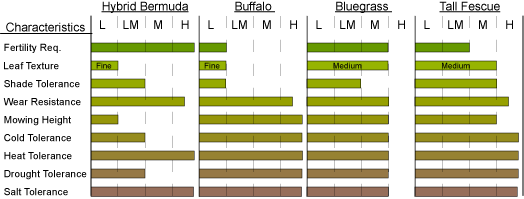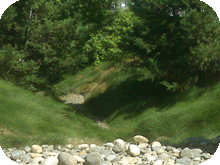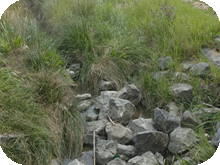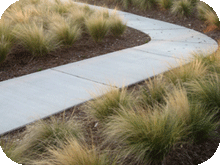
This mailer has been provided as an avenue to disperse information pertinent to public agencies and the landscape architecture profession in hopes of fostering greater understanding and collaboration. Topics address issues that affect the built environment within which we live.
Turf Grasses in California Landscapes
"I believe a leaf of grass is no less than the journey-work of the stars",Walt Whitman
As Californians continue to deal with limited water supplies and focus on water conservation, the first landscape feature to be belittled and ridiculed is the water-monging turf grass. Less grass in the landscape logically means less water use. This train of thought is far less accurate than it used to be however. This LAND Connections issue will focus on grass varieties for California landscapes and mixes being developed that will lower water use and minimize maintenance requirements.
Choosing the right grass for your project requires thought into the many characteristics of turf grasses. Some of these include fertility requirements, leaf blade texture, shade tolerance, wear resistance, mowing heights, cold tolerance, heat tolerance, drought tolerance, thatching tendencies, pH requirements, salt tolerance and maintenance requirements. The information below should give you a general understanding of the types of grasses available.
Warm Season Grasses -
Warm season grasses are typically used in southern California and the San Joaquin Valley landscapes. Warm season grasses are very effective at growing in hot areas with less water than cool season grasses. In general warm season grasses require 20% less water to maintain optimum conditions.1 Some benefits associated with warm season grasses are that they have high drought tolerance, high heat tolerance, high wear recovery, and high disease resistance. The down side is that in areas where the winter months are cooler the grasses go dormant and new growth is usually horizontal. Common warm season grasses include hybrid Bermuda grass, St. Augustine grass, zoysia grass, buffalo grass, and kikuyu grass.
Cool Season Grasses -
Cool season grasses are used in much of California for their ability to stay green year-round in mild climates. They are widely used for residential lawns, athletic fields, commercial properties and streetscapes. The use of ornamental grasses within the landscape is also becoming popular and can minimize the use for manicured expanses of turf. Generally unfavorable characteristics of cool season grasses include moderate to low drought tolerance, high water use requirements and moderate to low heat tolerance.
In recent years the popularity of cool season grasses has led to the commercialization of many new cultivars and widespread use of fine fescues. Fescue grasses tend to require less input, maintenance, and in some cases less water. The four most common fine fescues are creeping red fescue, chewings fescue, sheep fescue, and hard fescue. Of these the creeping red fescue has shown to be the overall superior choice for turf quality.2
In addition to the commercial availability of fine fescues the landscape industry is working diligently to create sod blends of native grasses that will satisfy the need for green turf without sacrificing the water it normally takes to achieve it. The Delta Bluegrass company has recently released a new line of California native sods that are reported to stay green at 50% of average ETo rates. Their new line of sods includes blends meant for urban landscapes and restoration sites. Their urban landscape sods include a native no-mow grass and two varieties that do not react negatively to mowing, a native bent grass and a delta grassland mix.3 More information on these grasses can be found at their website.
Comparisons -
The graph below is an example of the differences between grass characteristics and site requirements. Two-warm season and two cool season grasses are shown. Levels shown between low and high are relative to their designation as a cool or warm season grass.

This graph modified from information located at BaileySeed. BaileySeed's website contains additional information on these and other grass species.
1. University of California. 2009. Managing Turf Grasses During Drought. UC Agriculture and Natural Resources Communication Services. Publication 8395.
2. Harivandi,M. Ali, W. Bill Hagan and Roy Yokote. Mowed and Non-Mowed Fineleaf Fescue Performance when Irrigated with Recycled Water. University of California Cooperative Extension.
3. Delta Bluegrass Product Material
The next time you need a Landscape Architect on your project, consider O'Dell Engineering's Landscape Architecture Department.
Services include:
- Park and Playground Design
- Recreational Facility Design
- Site Planning
- Streetscape Design
- Urban Design
- Commercial Design
- 3-D Visualizations
- Graphic Design
- Arborist Consulting
![]()




Author: Chad Kennedy, Landscape Architect
This informational article provided by O'Dell Engineering - 1165 Scenic Drive, Suite A, Modesto CA 95350
